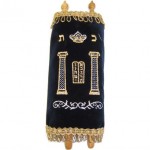The monumental occasion of Har Sinai is relived in Shul four times a week at Kriyas HaTorah. How so? The Mishna Berurah (Shulchan Aruch Orach Chayim 141, seif katan 16) writes that the Ba’al Kriyah is the Shul’s equivalent of Moshe Rabbeinu, relating the Torah to all assembled–men and women, young and old–at the behest of the Gabbai, who kevayachol, is “in the place of” Hashem, designating whom he wants to call to the Torah to hear its teaching.
The person receiving the aliyah represents K’lal Yisrael, serving as their special, designated representative! With this in mind, and for the rest of our lives, the Kriyas HaTorah we experience–whether on a Monday or Thursday, Shabbos or Yom Kippur must take on new and precious meaning, as we feel the unique privilege of our participation in an absolutely incomparable event! We provide several important Halachos relating to Kriyas HaTorah on an ongoing basis, excerpted from the Mishna Berurah–Dirshu Edition, (Chapters 147-149):

A. The Chofetz Chaim writes: “Ashrei Me Shenosein Kavod LaTorah–Praiseworthy is the one who honors the Torah, as the Pasuk says “Ki MiChabdai Achabeid”. Thus, when one honors the Torah it is considered as if one has honored Hashem Himself. (Bi’ur Halacha, d’h Vehanachon).
B. The opening of the Aron Kodesh is a remez to a “Sod Gadol BeOlamos HaElyonim” (Elef HaMagen; Dirshu Note 11).
C. The Rema writes that the reason that children are brought or urged to go to kiss the Torah is lechancham u’lezarzam b’mitzvos–to educate and to teach them to pursue the Mitzvos–rather than perform Mitzvos passively, or to wait for the mitzvah to come to the person. (ibid., 149:1)
D. The Chazan holds the Sefer Torah with the open part towards the people because “the light of the Sefer Torah” emanates to the Tzibbur from the side by which it opens(!). (ibid., note 16) Hakhel Note: Let us appreciate the light of the Sefer Torah when we are in its presence–whether or not we see it!
E. The Chazon Ish rules that when the Gemara states that the one who lifts the Torah is ‘notel sechar k’neged kulam’ (his reward is commensurate with all of those who were called to the Torah)–this in our day refers not only to the magbe’ah, the one who lifts the Torah, but also to the golel, the one who wraps the Torah. This being said, why do we sometimes given gelilah to a child under Bar-Mitzvah? The Mishna Berurah answers the question–gelilah should, in fact, only be given to a katan who is of an age in which he understands what a davar shebekedusha is–and the reason we do so is to properly educate him in the Mitzvos. (Shulchan Aruch, Orach Chaim 147, Mishna Berurah, seif katan 7)
F. HaRav Shlomo Zalmen Auerbach, Z’tl, rules that the kaddish immediately following Kriyas HaTorah was instituted le’ilui the Neshamos all of the meisim who do not have someone to say Kaddish over them, and that if an aveil (and not the ba’al kriyah) recites this Kaddish, then he should have in mind that he is reciting it for the Neshamos of these other meisim as well. (Dirshu, note 19)
G. On Simchas Torah, HaRav Chaim Brisker, Z’tl, would not give away the Sefer Torah to someone else, but would wait until someone took it from him. (ibid., note 21)
H. When the Sefer Torah is being returned to the Aron: (i) it is a hiddur to escort it back, as the Pasuk says “Acharei Hashem Elokeichem Teileichu”, (ii) even if the Sefer Torah is not passing in front of the person, he should move closer a bit, to be able to see it at a closer distance, (iii) if one is unable to kiss the Torah with his mouth, he should at least use his hand (so that an effect of Kedusha is left on his hand), and (iv) if possible, if one is close enough it is preferred that he hug the Torah with his right hand. (Shulchan Aruch, Orach Chaim 149, Mishna Berurah, seif katan 3 and Dirshu note 5)
The Fifth of the Aseres HaDibros is the Mitzvah of Kibbud Av VaEim. This Dibra is the only one in the leining which describes the reward for its performance–so that your days will be lengthened upon your land that Hashem gives you. HaRav Chaim Kanievsky, Shlita, was asked whether, in addition to length of days, the reward also implied good health during the lengthened days. He replied that even though the reward does not absolutely imply briyus–but it is ‘yitachein’– it can well be it includes good health as well(!). We provide this Teshuva in order to especially emphasize the great care in which one should undertake the Mitzvah of Kibbud Av VaEim. Strikingly, Rabbeinu Sa’adya Gaon writes that: “And that which the pasuk established the reward for honoring one’s parents as length of days is because sometimes a person’s parents can live a long time and could be perceived by the children as a heavy burden. Therefore, Hashem by providing the reward of long life, indicates to the children that you should give them their due honor in their older age and live with them–and if one is mitzta’er because of their life then he is essentially being Mitzta’er on his own life–for his length of days comes through his parents!

Leave a Reply